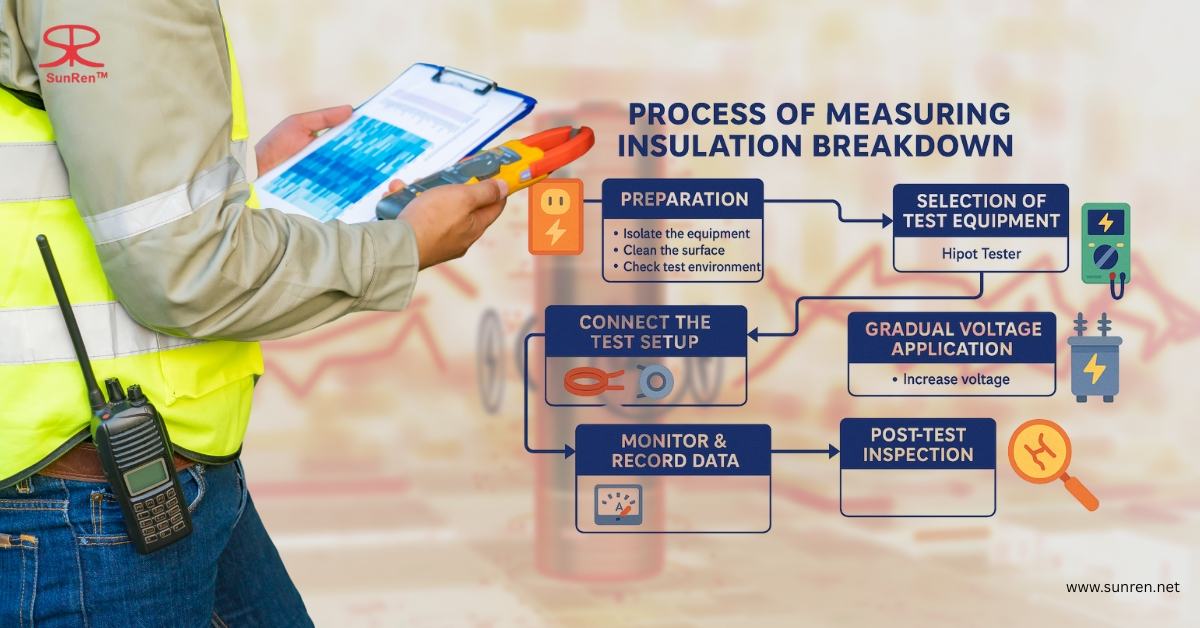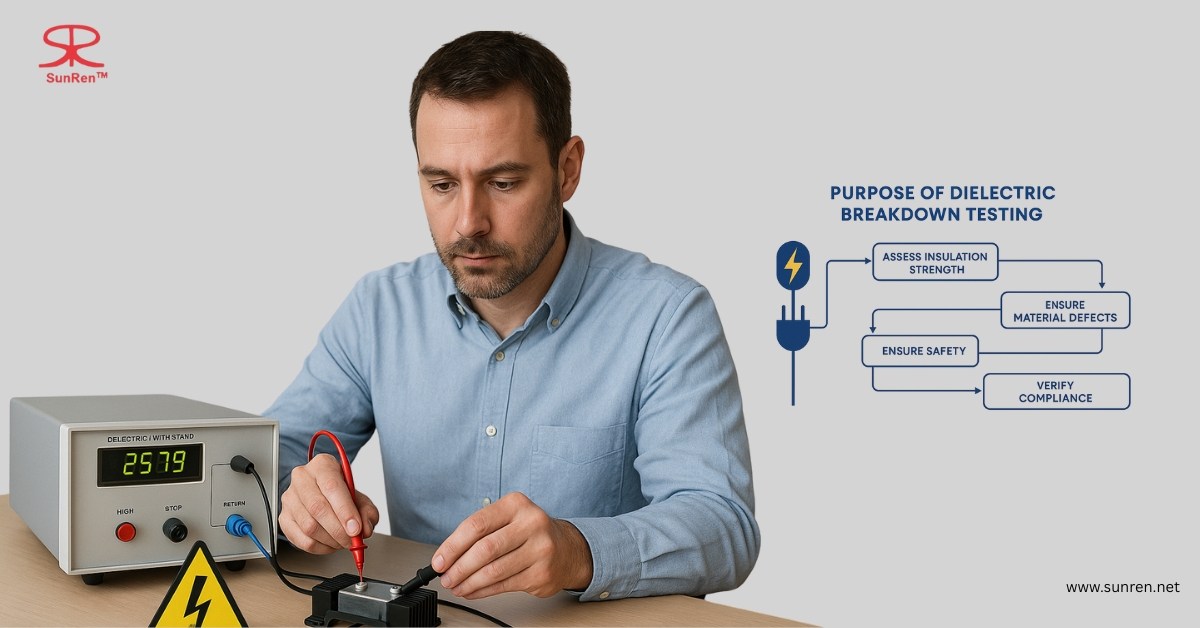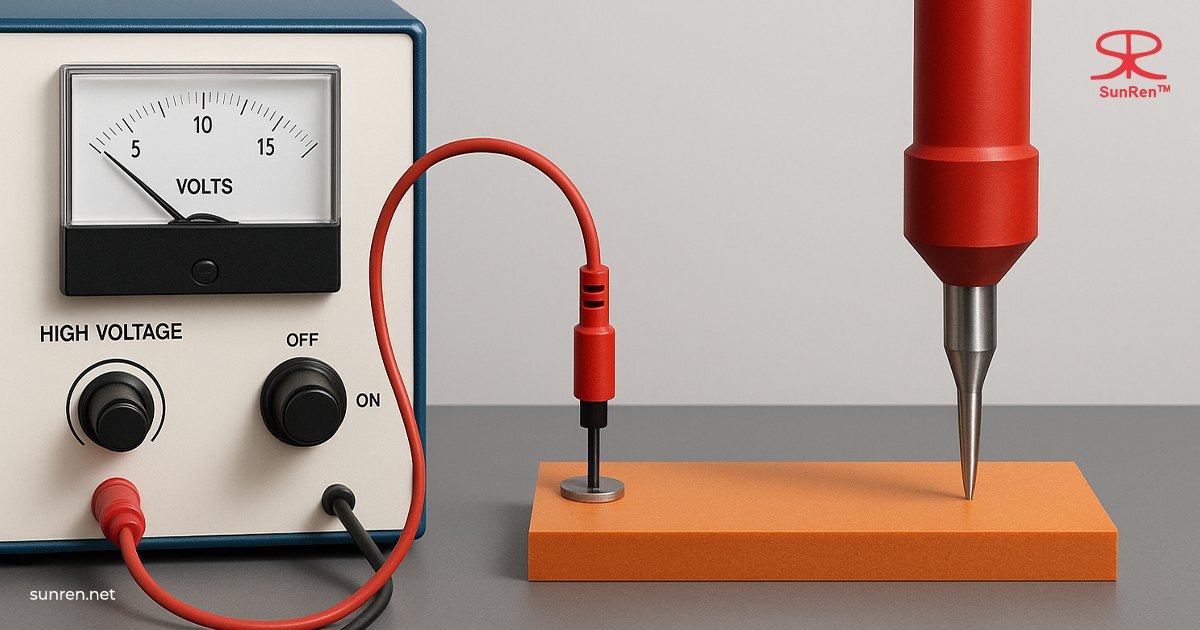Analysis of dielectric breakdown, together with its vital role in the field, Electrical insulation systems experience an essential breakdown called dielectric breakdown.
A dielectric breakdown takes place when an insulating material fails to retain its resistance against electrical stress, thus allowing a quick flow of current to pass through.

When insulation fails to protect equipment, the failure leads to electrical equipment breakdown, which causes malfunctions and system failures that may escalate to hazardous incidents, including fires or explosions.
Insulating material strength evaluation under high-voltage conditions happens through dielectric breakdown testing to avoid system failures.
The testing procedure identifies the peak voltage threshold that insulators can handle before electrical breakdown results in uncontrolled current transmission.
What is the process of measuring insulation breakdown?

An Insulation Breakdown Test stands as an essential procedure that evaluates the quality of insulating materials.
The electrical assessment of an insulating material depends on the insulation breakdown test. The inspection technique protects electrical systems from breakdowns by assessing what voltage can cause insulation failure.
The insulation breakdown tester remains the essential device for testing since it both generates high voltage for the material and records its reactions.
Purpose of Dielectric Breakdown Testing

A Dielectric Breakdown test serves these main objectives:
- Ensuring electrical safety: Electrical safety performs a crucial role by stopping catastrophic failures that result from insulation failure.
- Evaluating insulation performance: Benefit assessment of insulation materials includes determining which ones fulfill industry safety regulations.
- Preventing premature failures: The testing system identifies insulation weaknesses to prevent system disruptions.
- Compliance with regulations: Meeting industry and governmental safety standards for electrical equipment.
- Enhancing reliability of electrical systems: The enhancement of electrical system reliability requires materials to maintain durability during operational periods.
- Predicting material lifespan: Prediction of material durability requires knowledge about insulation material degradation patterns when they experience electrical stresses.
Various approaches exist for dielectric breakdown testing

A dielectric breakdown voltage test gets performed through multiple techniques according to specific material kinds and application needs. Below are some widely used techniques:
1. AC Dielectric Breakdown Test
This test applies an alternating current (AC) voltage to the insulating material. This test method helps determine how electricity affects an insulation’s ability to handle continuous usage in actual conditions. AC dielectric breakdown testers run through a process of voltage elevation until it reaches the breakdown point.
Advantages:
- Simulates real operating conditions for electrical systems.
- Helps identify weaknesses in insulation layers.
Disadvantages:
- Requires specialized equipment.
- Not ideal for materials that degrade under continuous voltage exposure.
2. DC Dielectric Breakdown Test
Testing the insulation resistance against high-voltage stress occurs through the application of direct current (DC) voltage. The examination technique proves highly effective for detecting insulation deterioration when used in applications with extended use.
Advantages:
- Suitable for long-term testing of insulation materials.
- Less complex than AC testing.
Disadvantages:
- Not representative of actual AC operating conditions.
- May not detect certain insulation defects.
3. Step-by-Step Voltage Ramp Test
The method involves raising voltage at multiple incremental levels until it results in breakdown. The test provides exact breakdown voltage measurements, which serve as a widely adopted tool for research laboratories and quality testing facilities.
Advantages:
- Allows for controlled testing with incremental voltage increases.
- Helps determine the exact breakdown voltage of a material.
Disadvantages:
- Time-consuming compared to other methods.
4. Oil Dielectric Breakdown Voltage Test
During electrical stress assessments on high-voltage equipment, transformers utilize the oil dielectric breakdown voltage test to evaluate their fluid’s insulation competency. This testing method proves necessary for safety reasons because it evaluates how contaminants and moisture react to aging processes in insulating oil.
Advantages:
- Ensures that transformer oils are safe for operation.
- Detects contamination and degradation in insulating fluids.
Disadvantages:
- Requires specialized oil dielectric breakdown voltage test equipment.
- Only applicable to fluid-based insulation.
Equipment Used in Dielectric Breakdown Testing
To conduct these tests, specialized instruments such as:
- Insulation breakdown tester – Used to apply high voltage and measure breakdown characteristics.
- AC dielectric breakdown tester – Measures breakdown voltage in AC systems.
- Dielectric breakdown voltage test apparatus – General equipment used for various breakdown testing methods.
- Oil dielectric breakdown voltage test equipment – This equipment uses oil as its dielectric material to generate breakdown voltages accurately for transformer and insulating oil measurements.
Factors Affecting Dielectric Breakdown Voltage
Multiple elements determine the dielectric breakdown strength of insulating materials as follows:
1. Material Composition
Different insulating materials, such as polymers, ceramics, and oils, have varying dielectric strengths. The choice of insulation affects overall electrical system performance.
2. Moisture Content
The insulation resistance of materials decreases as water contamination occurs, which increases their breakdown susceptibility. Moisture tests should be performed on insulating oils together with polymers.
3. Temperature Effects
Temperature elevation causes degradation of insulation materials while simultaneously decreasing their dielectric strength. Thermal aging is a significant factor that leads to early equipment failure.
4. Thickness of the Insulation Layer
The dielectric strength increases with thicker insulation layers, yet excessively thick insulation prevents practical design implementation.
5. Environmental Contaminants
The breakdown voltage of insulation decreases when exposure occurs to dust combined with chemical threats and industrial pollutants.
Industry Applications of Dielectric Breakdown Testing
Industrial applications of dielectric breakdown testing occur in different sectors, which include:
- Power Generation & Distribution – The company maintains insulation integrity through its transformer and high-voltage cable components within power generation and distribution systems.
- Electronics Manufacturing – The testing of circuit boards together with capacitors and insulating materials in electronic components is performed in Electronics Manufacturing.
- Automotive Industry – The evaluation of insulation performance takes place in electric vehicle (EV) and hybrid systems.
- Aerospace Industry – The aerospace industry relies on JURIX to test insulation materials used in aircraft electrical systems.
- Medical Equipment – Insulated medical devices as well as power supplies need to operate safely.
Frequently Asked Questions (FAQ)
What is meant by dielectric breakdown?
Dielectric Breakdown is the failure of an insulating material when subjected to excessive voltage, causing it to become conductive.
What is the purpose of a dielectric test?
The purpose of a Dielectric Test is to assess the insulating strength of a material by applying high voltage and ensuring it prevents unintended current flow.
What is dielectric discharge test?
It measures the residual charge in an insulating material after the voltage is removed, ensuring minimal stored energy and safe operation.
What is meant by dielectric breakdown?
Dielectric Breakdown occurs when an insulating material fails under high voltage, becoming conductive and allowing current to pass through.
What is the purpose of the breakdown voltage test?
The purpose of the Breakdown Voltage Test is to determine the maximum voltage an insulating material can withstand before failing, ensuring safety and reliability in electrical applications.
Conclusion
A dielectric breakdown test functions as an essential procedure to preserve electrical system security. The combination of different testing techniques alongside appropriate insulation breakdown testers allows industries to achieve equipment reliability alongside safety standard compliance. Regular inspection and maintenance of insulation components help to stop electrical system failures and safety risks.
Implementing electrical insulation breakdown tests within quality control procedures allows industries to improve the reliability together with the safety and operational efficiency of electrical systems. Different evaluations test the breakage of AC dielectric voltage and oil dielectric voltage and solid insulation components for electrical engineering applications.



